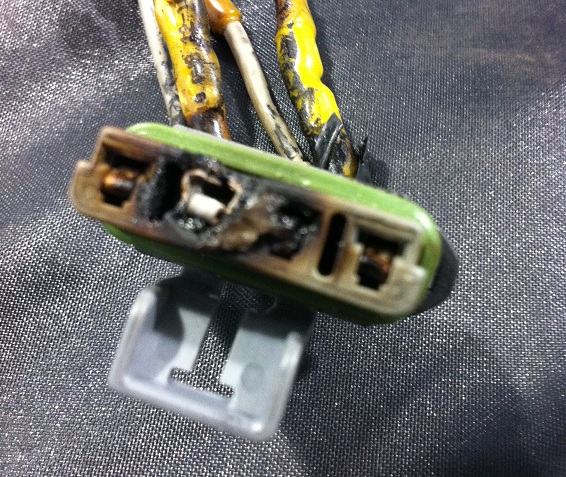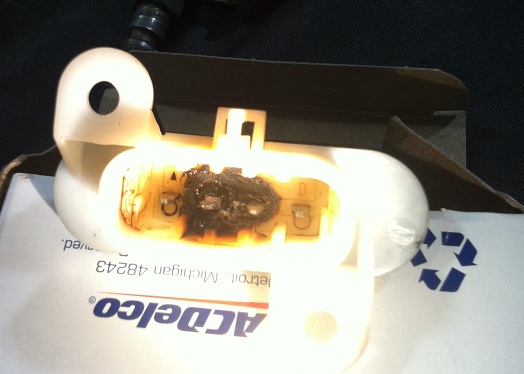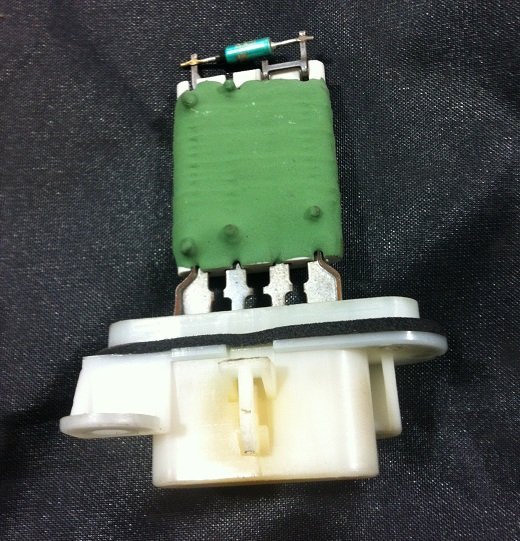This one has been a big issue over the years. Many, many times a car or truck will come into the shop with the customer complaining that their blower motor doesn’t work, or only works on high speed, etc. This is usually the case after a blower resistor failure on one or more speed settings. What is happening to them you ask? Well, the resistor itself has quite an electrical draw to keep that blower motor powered up. It send a certain amount of voltage to the motor to have it spin at the requested speed you select on the control head.
To do this, there are resistors built into the unit to control the voltage. If you are not familiar with how electricity works, basically it comes down to this…resistance causes heat. This heat, over the years, can end up burning up and shorting out the blower resistor and associated wiring. Upon diagnosis to this kind of customer complaint, I will normally find a burned up blower resistor and wiring connector.
There have been many attempts at redesigns to the resistor and wiring…even sometimes adding a control module to the resistor assembly to help regulate voltage and cause less heat to the electronics inside. At times it works, other times not so well. There have even been manufacturer recalls associated with some of these cars and trucks to replace the resistor and connector, since they know there is a common problem with them.
I do this repair on a regular basis, since so many suffer this problem and subsequent failure of the blower motor to work. Just the other day I decided to document one repair and take some pictures of the failed parts.
After diagnosis, which is usually pretty straight forward since I’ve seen this a lot, I just have to replace the resistor assembly and wire in a new connector. It’s a not a bad job, and with the experience I have, I can knock these out pretty quick. Removal of the right side dash trim is usually all it takes to access the heater/blower area of the vehicle. A couple screws later and the resistor is out and unplugged from the blower motor. Installation of the new resistor is just as easy, and has a new harness that plugs into the existing blower motor. Now it gets just a tad more intricate. There can be anywhere from five to seven wires in this system that all have to be cut, stripped and wired into the new connector provided. Unfortunately, the wire colors are usually pretty basic, so you have to make sure to match up each wire correctly. After connecting with heat shrink connectors, it’s all good to go. Reinstall any remaining trim panels, covers, etc, and you’re all done. All the blower speeds should be functional and the customer smiling again!
You can see in the pictures below, how badly these things can burn up and melt. This gives you an idea of how much heat can be produced in this electrical system! If you’re experiencing a problem with your blower speeds not working, this is more than likely the problem!



Live Chat
My 1999 Olds Delta 88 heater fan switch turns blower on only occasionally and even then the high setting cuts off the fan(if it’s working).
ProTech:
Probably a bad blower motor resistor you have there, or possibly a faulty blower motor or switch. The most common thing would be the resistor assembly, as that goes out more often than the other parts. A quick check with a test light can determine failure.
Leave comments below or see these

Leave A Comment, Reply Or Ask A Question
5 Comments on "Some Blower Motor Fan Speeds Not Working"
My heater was working and when I put the switch on 5 and it makes a weird noise, it stopped working and there has been times I would hit a bump and it would come on, now it don’t come on at all. Is it the switch, blower motor, or the resistor?
Sounds like either the blower motor is bad, or the wiring connection at the blow motor.
I replaced both heater resistor and relay since motor did not work at all.
All 4 speeds work for about a week now 1-2 no longer work.
What to check before putting in a new resistor and have it fail as well
My blower works on settings 1,2 and 3 in my Saturn Vue but no temperature change. When I turn the setting to 4 the blower turns completely off. Any help is appreciated?
My ex gf had this problem in her Saturn. I had to replace the selector switch twice, but that fixed the issue each time